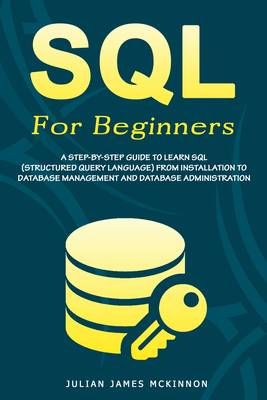
- Retrait gratuit dans votre magasin Club
- 7.000.000 titres dans notre catalogue
- Payer en toute sécurité
- Toujours un magasin près de chez vous
- Retrait gratuit dans votre magasin Club
- 7.000.0000 titres dans notre catalogue
- Payer en toute sécurité
- Toujours un magasin près de chez vous
SQL For Beginners
A Step-by-Step Guide to Learn SQL (Structured Query Language) from Installation to Database Management and Database Administration
Julian James McKinnonDescription
Anything that stores data records is called a database. It can be a file, CD, hard disk, or any number of storage solutions. From a programming point of view, a database is a methodically structured repository of indexed data information that can be easily accessed by the users for creating, retrieving, updating and deleting information.
Data can be stored in many forms. Most applications require a database for storing information. A database can be of two types:
(1) flat database and (2) relational database.
As the name suggests a flat database has a two-dimensional structure that has data fields and records stored in one large table. It is not capable of storing complex information, which creates a need for relational databases. A relational database stores data in several tables that are related to each other.
Let's take the example of a school.
A school will have to maintain data for several students. To find information for a student, we will first ask the class name. After the class name, we will ask for the first name. However, if there are two children with the same first name, then we will ask for the surname.
If there are two children will identical names, we can still discriminate the information related to them based on their student id, parents' name, date of birth, siblings in the same school, etc.
This is all related information. When all of this information is stored on paper, it takes a lot of time to retrieve it. The relational database allows easy access to all of this information.
SQL is a computer language we can use to work with the various database management systems. It is the standard language for the various relational database management systems such as Oracle, MySQL, MS Access, SQL Server, Postgres, Sybase, etc. With the use of SQL, a database user can create various database objects and perform various manipulations on them.
When they have accomplished the tasks, they were using the objects for, the users can drop these database objects. A good example of a database object is a table which is a combination of rows and columns. Tables allow us to group our data into rows and columns.
SQL allows you to create a table, insert data into it, manipulate this data and even drop it when you are done with its use.
Besides this, SQL allows you to impose constraints on the table to restrict the data that can be inserted into that table. You must have data you need to store well. The data should be safeguarded against loss. If the data is sensitive, you need to safeguard it so it doesn't land into the wrong hands.
You also need a way of organizing this data so it becomes easy for you to retrieve it. You only need to get a database management system and SQL will help you achieve all of this.
This book is an excellent guide for you to learn SQL. It explores everything about this computer database language.
Spécifications
Parties prenantes
- Auteur(s) :
- Editeur:
Contenu
- Nombre de pages :
- 204
- Langue:
- Anglais
Caractéristiques
- EAN:
- 9781801235037
- Date de parution :
- 08-11-20
- Format:
- Livre broché
- Format numérique:
- Trade paperback (VS)
- Dimensions :
- 152 mm x 229 mm
- Poids :
- 281 g

Les avis
Nous publions uniquement les avis qui respectent les conditions requises. Consultez nos conditions pour les avis.






